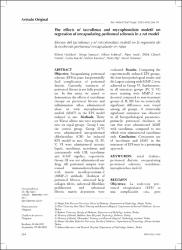| dc.contributor.author | Huddam, Bülent | |
| dc.contributor.author | Şaşmaz, Simge | |
| dc.contributor.author | Haberal, Nihan | |
| dc.contributor.author | Azak, Alper | |
| dc.contributor.author | Gibyeli Genek, Dilek | |
| dc.contributor.author | Koçak, Gülay | |
| dc.contributor.author | Karakuş, Volkan | |
| dc.contributor.author | Alp, Alper | |
| dc.contributor.author | Duranay, Murat | |
| dc.date.accessioned | 2021-12-23T13:38:22Z | |
| dc.date.available | 2021-12-23T13:38:22Z | |
| dc.date.issued | 2021 | en_US |
| dc.identifier.issn | 0326-3428 | |
| dc.identifier.issn | 2346-8548 | |
| dc.identifier.uri | https://hdl.handle.net/20.500.12809/9717 | |
| dc.description.abstract | Objective: Encapsulating peritoneal sclerosis (EPS) is a rare, but potentially fatal complication of peritoneal dialysis. Currently, treatment of peritoneal fibrosis is not fully possible yet. In this study, we aimed to demonstrate the effects of tacrolimus therapy on peritoneal fibrosis and inflammation when administered alone or with mycophenolate mofetil (MMF) in the EPS model induced in rats. Methods: Thirty six Wistar albino rats were separated into six equal groups. Group I was the control group. Group II-VI were administered intraperitoneal chlorhexidine (CH) for induced EPS model in rats. Group II, IV, V, VI were administered isotonic liquid, tacrolimus, tacrolimus and concurrently with CH, tacrolimus and MMF together, respectively. Group III was not administered any drug. All peritoneal samples were stained immunohistochemically with matrix metalloproteinase-2 (MMP-2) antibody. Thickness of peritoneal fibrosis, subserosal large collagen fibers, subserosal fibroblast proliferation and subserosal fibrotic matrix deposition were evaluated. Results: Comparing the experimentally induced EPS groups, the best histopathological results and the largest staining with MMP-2 were achieved in Group VI. Furthermore, in all treatment groups (IV, V, VI) more staining with MMP-2 was detected compared to non-treatment groups (I, II, III) but no statistically significant differences were found among all groups. A statistically significant remission was observed in all histopathological parameters, primarily peritoneal thickness in rats that were administered MMF with tacrolimus, compared to rats which were administered tacrolimus only. Conclusion: Concurrent use of tacrolimus and MMF in the treatment of EPS may be a promising approach. | en_US |
| dc.item-language.iso | eng | en_US |
| dc.publisher | ASOC REGIONAL DIALISIS TRASPLANTES RENALES | en_US |
| dc.item-rights | info:eu-repo/semantics/openAccess | en_US |
| dc.subject | Renal dialysis | en_US |
| dc.subject | Peritoneal dialysis | en_US |
| dc.subject | Encapsulating peritoneal sclerosis | en_US |
| dc.subject | Tacrolimus | en_US |
| dc.subject | Mycophenolate mofetil | en_US |
| dc.title | The effects of tacrolimus and mycophenolate mofetil on regression of encapsulating peritoneal sclerosis in a rat model | en_US |
| dc.item-type | article | en_US |
| dc.contributor.department | MÜ, Tıp Fakültesi, Dahili Tıp Bilimleri Bölümü | en_US |
| dc.contributor.authorID | 0000-0002-8412-1584 | en_US |
| dc.contributor.authorID | 0000-0001-6104-5577 | en_US |
| dc.contributor.authorID | 0000-0002-2864-361X | en_US |
| dc.contributor.institutionauthor | Huddam, Bülent | |
| dc.contributor.institutionauthor | Gibyeli Genek, Dilek | |
| dc.contributor.institutionauthor | Alp, Alper | |
| dc.identifier.volume | 41 | en_US |
| dc.identifier.issue | 4 | en_US |
| dc.identifier.startpage | 264 | en_US |
| dc.identifier.endpage | 274 | en_US |
| dc.relation.journal | REVISTA DE NEFROLOGIA DIALISIS Y TRASPLANTE | en_US |
| dc.relation.publicationcategory | Makale - Uluslararası Hakemli Dergi - Kurum Öğretim Elemanı | en_US |


















